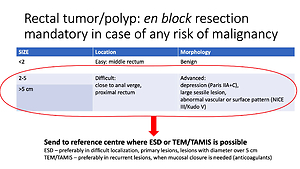Current issue
Archive
Manuscripts accepted
About the Journal
Editorial office
Editorial board
Section Editors
Abstracting and indexing
Subscription
Contact
Ethical standards and procedures
Most read articles
Instructions for authors
Article Processing Charge (APC)
Regulations of paying article processing charge (APC)
ONCOLOGY / RESEARCH PAPER
Endoscopic submucosal dissection for rectal neoplastic lesions: experience from a European center.
Adam Dziki
2,1
1
Center of Bowel Treatment, Brzeziny, Poland
2
Medical University of Lodz, Poland
Submission date: 2021-06-14
Final revision date: 2021-11-13
Acceptance date: 2021-11-27
Online publication date: 2021-12-08
Corresponding author
KEYWORDS
TOPICS
ABSTRACT
Introduction:
Nowadays, various endoscopic resections including polypectomy, endoscopic mucosal resection (EMR), and endoscopic submucosal dissection (ESD) are well known first-line approaches for early neoplastic rectal tumors.
Material and methods:
In this case series study, we analyzed 320 ESD procedures performed in a high-volume colorectal center in Poland, Europe. The aim of this study was to retrospectively evaluate ESD procedure in cases of rectal carcinoma performed by a single trained operator in a referral center provided with endoscopy.
Results:
Overall, en bloc resection was observed in 92.5% of patients (296/320). The en bloc resection rate was at a similar level in those lesions with involved anal sphincters versus tumors without involvement (93.85% vs. 92.16%; p=0.644). R0 resection was noted in 89.4% of patients (286/320). The overall curative ESD rate was 85.94% (n=275). The curative ESD rate in the invasive cancer group reached 52.6% (n=20). We observed ESD-related adverse events, such as bleeding and perforation, in 3.4 % of patients (n=11).
Conclusions:
We have demonstrated that ESD in rectal tumors is an efficient and safe procedure with a high curative rate, even in difficult lesions. Anal sphincter localization and recurrent character of the lesion have no impact on the final outcomes. The ESD approach should have been considered for all rectal tumors, especially those lesions suspected of superficial mucosal invasion, as it can serve as a staging method and may have been curative for adenomas and cancers limited to mucosa.
Nowadays, various endoscopic resections including polypectomy, endoscopic mucosal resection (EMR), and endoscopic submucosal dissection (ESD) are well known first-line approaches for early neoplastic rectal tumors.
Material and methods:
In this case series study, we analyzed 320 ESD procedures performed in a high-volume colorectal center in Poland, Europe. The aim of this study was to retrospectively evaluate ESD procedure in cases of rectal carcinoma performed by a single trained operator in a referral center provided with endoscopy.
Results:
Overall, en bloc resection was observed in 92.5% of patients (296/320). The en bloc resection rate was at a similar level in those lesions with involved anal sphincters versus tumors without involvement (93.85% vs. 92.16%; p=0.644). R0 resection was noted in 89.4% of patients (286/320). The overall curative ESD rate was 85.94% (n=275). The curative ESD rate in the invasive cancer group reached 52.6% (n=20). We observed ESD-related adverse events, such as bleeding and perforation, in 3.4 % of patients (n=11).
Conclusions:
We have demonstrated that ESD in rectal tumors is an efficient and safe procedure with a high curative rate, even in difficult lesions. Anal sphincter localization and recurrent character of the lesion have no impact on the final outcomes. The ESD approach should have been considered for all rectal tumors, especially those lesions suspected of superficial mucosal invasion, as it can serve as a staging method and may have been curative for adenomas and cancers limited to mucosa.
We process personal data collected when visiting the website. The function of obtaining information about users and their behavior is carried out by voluntarily entered information in forms and saving cookies in end devices. Data, including cookies, are used to provide services, improve the user experience and to analyze the traffic in accordance with the Privacy policy. Data are also collected and processed by Google Analytics tool (more).
You can change cookies settings in your browser. Restricted use of cookies in the browser configuration may affect some functionalities of the website.
You can change cookies settings in your browser. Restricted use of cookies in the browser configuration may affect some functionalities of the website.



